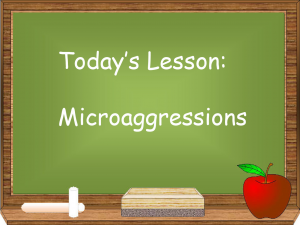 Our last post, Lunch and Learn: Teaching Discussion-based Classes, summarized two faculty presentations at a recent event. One issue that came up during the discussion was how to handle a situation where one student has polarizing views and makes comments that become disruptive to class discussion. If such situations are not handled appropriately, the classroom climate can be negatively affected. A related circumstance that can have an impact on how students feel about a class is how the instructor handles microaggressions.
Our last post, Lunch and Learn: Teaching Discussion-based Classes, summarized two faculty presentations at a recent event. One issue that came up during the discussion was how to handle a situation where one student has polarizing views and makes comments that become disruptive to class discussion. If such situations are not handled appropriately, the classroom climate can be negatively affected. A related circumstance that can have an impact on how students feel about a class is how the instructor handles microaggressions.
“Microaggressions are the everyday verbal, nonverbal, and environmental slights, snubs, or insults, whether intentional or unintentional, which communicate hostile, derogatory, or negative messages to target persons based solely upon their marginalized group membership. In many cases, these hidden messages may invalidate the group identity or experiential reality of target persons, demean them on a personal or group level, communicate they are lesser human beings, suggest they do not belong with the majority group, threaten and intimidate, or relegate them to inferior status and treatment.” [Sue, D.W., Microaggressions: More than Just Race, Psychology Today, November 17, 2010]
“Microaggressions come in many forms in the classroom: instructor to student, student to instructor, or student to student. All have a negative effect on classroom climate.” [IUPUI Microaggressions in the Classroom]
Because microaggressions are subtle, and sometimes unintended, it can be easy to overlook the harm that is caused. Instructors must be on guard against perpetuating microaggressions, as well as microinequities towards students (such as calling on male students more frequently than female), and be prepared to address students who exhibit these behaviors.
Here are a few resources to assist you:
The article by Derald Wing Sue cited above, Microaggressions: More than Just Race, is an excellent place to start. Originally the term was coined to describe biases against racial minorities; Sue presents the case that microaggressions are also directed at women, LBGTQ persons, those with disabilities, in fact, towards any marginalized group.
In Responding to Microaggressions in the Classroom: Taking ACTION (Faculty Focus, April 20, 2018), Tasha Souza, Ph.D. describes a strategy she calls ACTION for dealing with microaggressions. The acronym describes a “communication framework” and steps to take when a situation arises: Ask clarifying questions. Come from curiosity not judgment. Tell what you observed as problematic in a factual manner. Impact exploration by asking for, and/or stating, the potential impact of such a statement or action on others. Own your own thoughts and feelings around the impact. Take the Next steps by requesting appropriate action be taken. The ACTION framework gives instructors a tool to address microaggressions without escalating the situation.
The above referenced document from IUPUI (Indiana University-Purdue University Indianapolis), Microaggressions in the Classroom, provides a succinct summary of ways to create “a space where students can address difference and diversity in productive ways.” Instructors should inquire about the reasoning behind a student’s statement, use paraphrasing to reflect on the feelings and content of the speaker, use “I statements” to clarify your own feelings and remind students to be respectful of others, and redirect and reframe inappropriate comments. There are examples that will be helpful for you in your instructional practice.
A number of examples are presented in a detailed document from the Center for Multicultural Excellence at the University of Denver, also titled Microaggressions in the Classroom. The primary focus of this report is on faculty microaggressions and the goal is to help faculty create more inclusive classrooms. Seeing the examples may help you identify biases and correct them. There are concrete suggestions for addressing microaggressions.
Finally, Addressing Microaggressions in the Classroom from the Intercultural Center at Saint Mary’s College of California, presents some of the same content as the previous document in a shorter version. Definitions of microaggressions, examples, and suggestions for addressing the behavior in the classroom are covered in just over two pages.
Whether you are dealing with a student who is making polarizing statements, or with the subtler challenge of microaggressions, these resources will help you maintain civil discussions in a positive classroom environment.
Macie Hall, Senior Instructional Designer
Center for Educational Resources
Image Source: Modified image from Pixabay.com
